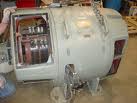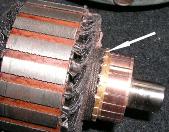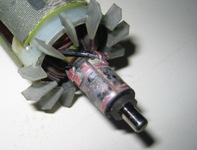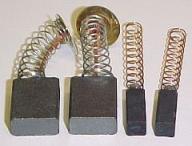Repair of collectors and brushes of electric machines with direct current
 During the operation of generators and motors with direct current, a pure spark is observed diversity, while grooves appear on its surface, the plates burn. As a result, the collector and brushes wear out quickly.
During the operation of generators and motors with direct current, a pure spark is observed diversity, while grooves appear on its surface, the plates burn. As a result, the collector and brushes wear out quickly.
Arcing on the collector can be caused by faults in the collector, brushes, brush holders and motor windings.
Malfunctions in the collector and their elimination
Surface roughness is the most common collector malfunction. Collector surface roughness is the result of scratches, carbon deposits or oxide layers on the collector.
Scratches are caused by solid particles caught on the collector under the brushes. Carbon deposits are formed from sparking and a layer of oxide on the collector appears after a long stay of the electric motor in places with high humidity.

Indentation... When the brushes are located against each other, after long-term operation of the electric motor, grooves are formed on the collector, the surface of the collector becomes wavy. This waviness is eliminated by a manifold groove on a lathe. To avoid channels, the brushes should be staggered.
Elevation of the micans above the plates. Micanite manifold gaskets are harder than copper plates. Therefore, in the process of work, they wear out less and gradually protrude above the surface of the plates.

Once through, clean all the channels between the collector plates with a hair brush and bevel the ends of the collector plates using a scraper. The collector is then sanded and blown with compressed air.
Manifold leakage can occur as a result of: motor bearing failure, uneven height of the manifold plates, which manifests itself in poor installation and incorrect alignment of the motor armature.
To eliminate manifold leakage, the defective bearing is repaired or replaced. If the collector leakage is due to the uneven height of the th plates, then the collector must be turned on a lathe until the leakage is eliminated.In the event of a deviation causing the collector to leak, the armature must be re-centered on a special machine.
Malfunctions of the brushes and their elimination
The brushes are badly ground, chipped at the edges or have scratches on the surface adjacent to the collector.
To eliminate this, carbon and graphite brushes should be ground against the collector with sandpaper. In this case, you should start with a large number of glass paper and gradually move to smaller ones.
It is forbidden to use sandpaper for grinding, because sandpaper dust clogged in the gaps between the collector plates closes them together.
 The brushes are incorrectly located on the collector... This can happen if they fit the collector plates on one side, or the stroke of the brush holders is not installed according to the factory markings on it and on the body.
The brushes are incorrectly located on the collector... This can happen if they fit the collector plates on one side, or the stroke of the brush holders is not installed according to the factory markings on it and on the body.
The relocated stroke must be installed according to the factory markings. In the absence of factory markings or their incorrectness (sparking is not eliminated), the brushes must be set to neutral, moving along the collector (for generators - in the direction of rotation, and for engines - in the opposite direction) until the sparking disappears completely .
The position of the brushes on the neutral corresponds to: for generators — their highest voltage at idle; for engines — the equality of the number of revolutions when rotating forward and backward.
One-sided sticking of the brushes can be eliminated by rotating the brush holder holder or by grinding to the collector if the brush holder holder is stationary.
Brushes that are not pressed against the collector or not firmly seated in the cage... This happens when the brush holder springs are not pressed against the brushes, the gap between the brush and the holder is too large, or when the traverse and the brush holder are poorly secured .
The pressure force on the brush is increased by adjusting the compression spring. In the absence of a regulating device, the spring is replaced with a stiffer one. To eliminate the vibration of the brush in the holder of the brush holder, it is replaced with a large one - in terms of the dimensions of the holder. If the brush vibration is caused by the loosening of the brush mechanism fasteners, then it is necessary to tighten the reinforcing bolts of the traverse and brush holders.
Excessive increase in the current passing through the brushes... If the current density in the brush exceeds the permissible value for a given type of brushes, this leads to inevitable overheating of the brushes.
If sparking on the collector continues after the removal of the considered faults, then the reason for this may be damage to the armature winding or the poles of the machine: short circuit, desoldering of the armature winding in the loops, breaking of the armature, short circuit to iron. In most cases, these faults are rectified by overhauling the DC machine.
